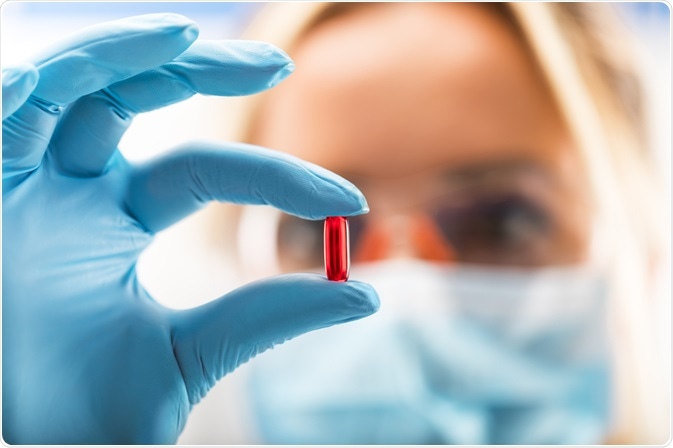Absorption-Distribution-Metabolism-Excretion (ADME) studies are used in the drug development process to investigate numerous factors that influence drug action and effectiveness.

Image Credit: Oleksiy Mark/Shutterstock.com
ADME studies are often not considered to be good laboratory practice (GLP) studies, therefore they are not suitable by themselves to establish the safety of a drug or for submission to regulatory bodies such as the Food and Drug Administration.
However, these studies are essential to expand a researcher’s knowledge on the behavior of a candidate drug, including how it influences the establishment, progression, remission, and aggression of certain diseases, along with what potential drawbacks there may be of using a particular drug (such as toxicity).
Using ADME studies to filter drug candidates
ADME studies gather this information by exploring five different factors. Firstly, they look at the absorption of the drug. This is a measure of how much of the drug is absorbed by the body, and how long it takes for the process of absorption to complete.
These studies also look at the distribution of the drug. This is an investigation of where the drug travels within the body, and at what speed.
In addition, ADME studies are used to evaluate drug metabolism by measuring the speed at which the body metabolizes the drug, and the physiological mechanisms involved. These studies can also assess whether or not the metabolites formed are toxic.
Elimination is the next factor ADME studies can explore. This refers to how the drug is excreted from the body and how quickly this happens. Finally, the toxicity of the drug is tested, with analyses gathering data on how the body’s systems and organs are impacted by the drug to check that it is safe to use.
Statistics estimate that almost half of the candidate drugs do not make it to clinical trials because they fail to meet suitable levels of efficacy, and around 40% fail because they have a toxic effect on the body, making them unsafe for use in humans.
Because of the high rates of toxicity in candidate drugs, along with high rates of ineffectiveness, ADME studies have become increasingly important to help scientists identify which drugs can move forward with the development, preparing them for clinical trials.
Due to their growing importance, ADME studies have now been incorporated into the early stages of the drug development process.
These studies can help eliminate unsuitable drug candidates early on to avoid wasting time on further development, and can also accelerate the drug discovery pipeline.
Increased need for new drugs boosts the importance of ADME studies
There is a growing need for new drugs that are driving the current boom in pharmaceutical research and drug development. This increased demand for new therapeutic approaches is due to several factors.
Firstly, the human population is living longer, and therefore illnesses such as cancer and neurodegenerative disorders are diagnosed more frequently.
In addition, healthcare professionals and patients alike are striving to be offered a wider range of therapeutic options to ensure that individual differences are accounted for when evaluating treatment outcomes and impact on quality of life.
All this calls for the development of new drugs that have different capabilities and work in different ways to current drugs, but that are just as safe or safer.
A closer look at some ‘traditional’ in vivo ADME studies
ADME studies such as in vivo studies looking at excretion balance, plasma (blood) levels for a metabolic profile, whole-body autoradiography (WBA), and toxicokinetics, are well established in drug research and drug development processes.
Rodents and non-rodent animals are usually used to perform excretion balance experiments. They are administered with the drug and then scientists collect and analyze their excreta, usually for five or six days, or more, if the drug’s half-life is longer.
The radioactivity of the excreta is measured, allowing scientists to evaluate the toxicity of the drug.
Plasma (or blood) can also be collected from animals that have been administered with the candidate drug and analyzed to characterize the metabolic profile. This allows scientists to gain an understanding of how fast the drug is metabolized by the body, and whether its metabolites are harmful.
WBA is a process that generates a ‘distribution map’ that allows scientists to determine where the candidate drug has spread in the body.
Usually, rodents are used to conduct these experiments where they are administered the drug and killed at various time points. Whole-body sections are then obtained from the carcass, dried and scanned to reveal the distribution of the drug.
Finally, toxicokinetics can be carried out to assess drug safety, by evaluating whether the drug has been properly absorbed or not and whether exposure to the drug is related to the dose.
The future of ADME studies
Recent years have seen rapid developments of in vitro technologies and there are now many emerging assays available to assess candidate drugs. Likely, these tests will eventually overtake the traditional in vivo studies that rely on the use of animal subjects.
Sources:
- Kassel, D. (2004). Applications of high-throughput ADME in drug discovery. Current Opinion in Chemical Biology, 8(3), pp.339-345. www.sciencedirect.com/science/article/abs/pii/S1367593104000614
- Pellegatti, M. (2012). Preclinical in vivoADME studies in drug development: a critical review. Expert Opinion on Drug Metabolism & Toxicology, 8(2), pp.161-172. https://www.ncbi.nlm.nih.gov/pubmed/22248306
- Whitworth, J. (2004). The need for new drugs: a response. Australian Prescriber, 27(6), pp.137-138. www.nps.org.au/.../the-need-for-new-drugs-a-response
- Solon, E., Kraus, L. (2001). Quantitative whole-body autoradiography in the pharmaceutical industry. Journal of Pharmacological and Toxicological Methods 46(2), pp 73-81
- https://www.sciencedirect.com/science/article/pii/S1056871902001612
Further Reading
Last Updated: Feb 3, 2021